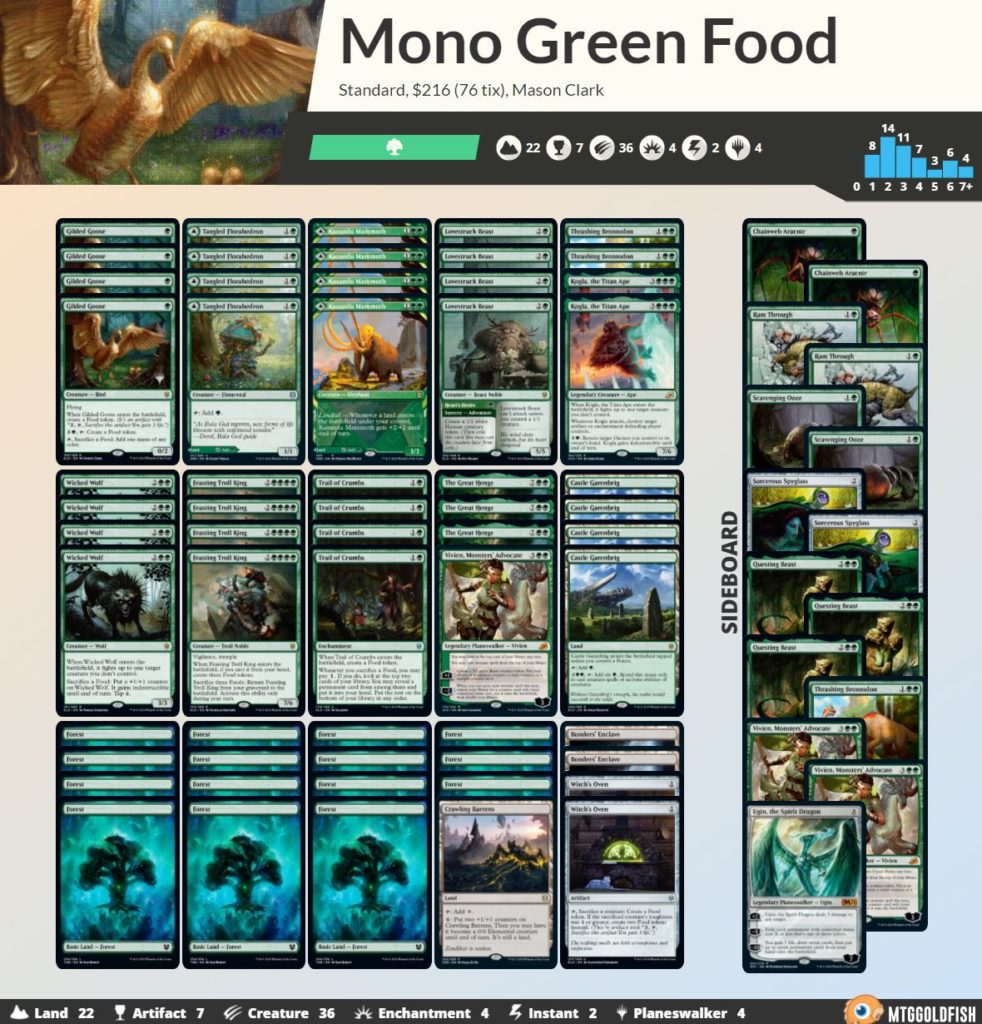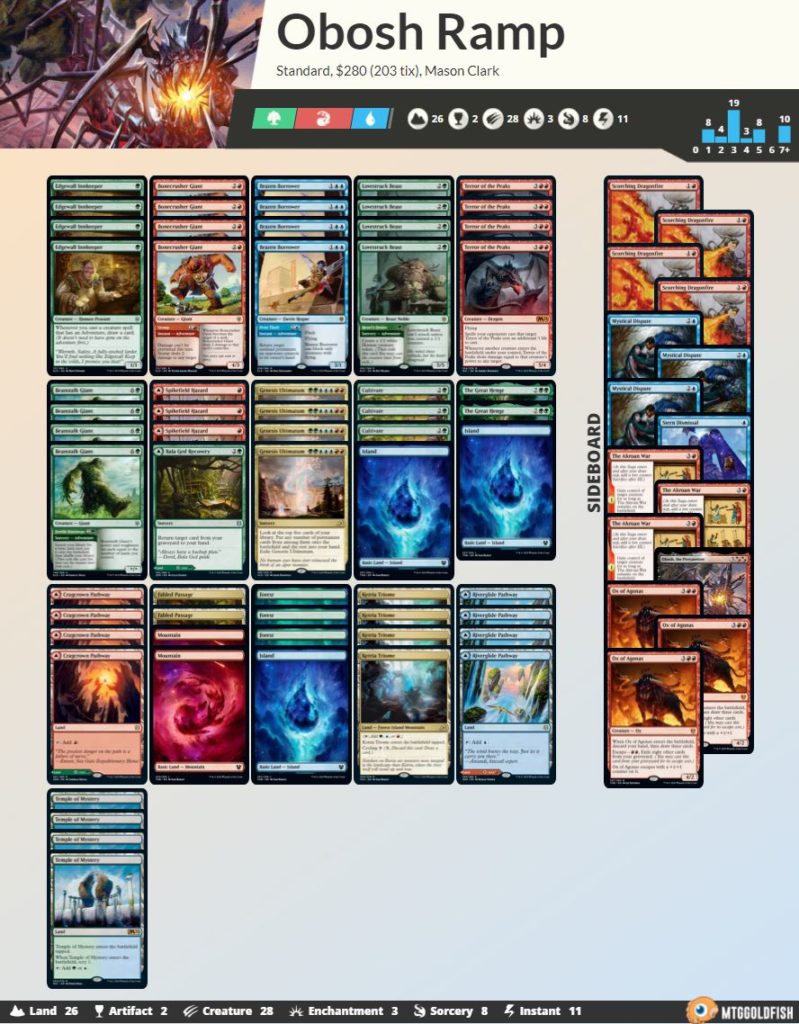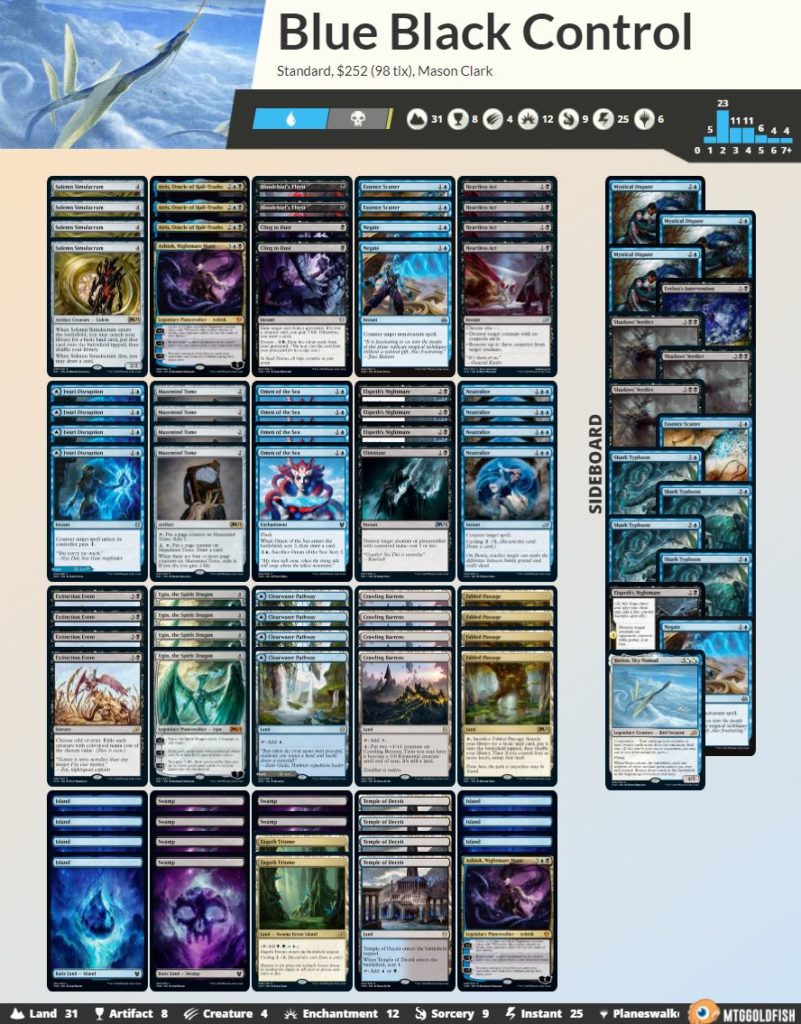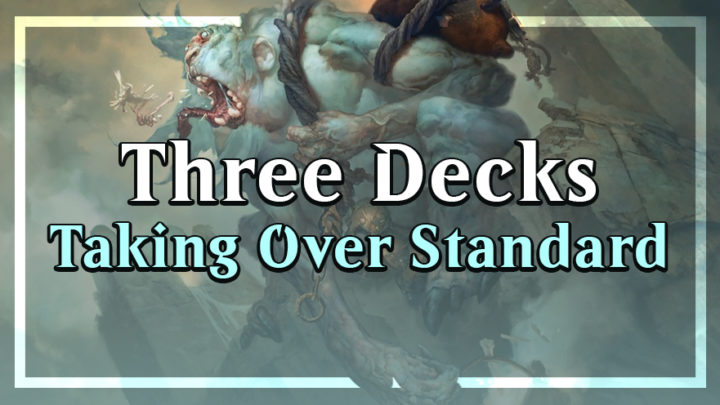Since the banning of Omnath, we have seen the Standard format blossom. We’ve had a lot of churn in the top decks, fun dynamic gameplay, and a good balance of decks. Typically, around this time in a format, we would be talking about how best to tune one of the three best decks we have been talking about for weeks.
But Zendikar Rising Standard continues to deliver. While Gruul, Dimir Rogues, and Rakdos Midrange were the big contenders just weeks ago, we now have a new best deck in Standard: Mono-Green Food. And even more recently, two new decks — Blue-Black Control and Obosh Ramp — have burst onto the scene to prey on it.
Today, we’re going to look at all three of these relatively new decks and how their presence has shaken up Standard.
Mono-Green Food

Buy this deck from Card Kingdom
Export this deck to Arena via MTGGoldfish
Mono-Green Food has been around for well over a month at this point, but it used to be much clunkier and much worse suited to the metagame. We published a tier list around this time, and I actually chose to omit the deck given how poorly positioned it was.
Fortunately for Mono-Green fans, the deck has changed a fair bit in that time. While the deck used to play more aggressive cards like Gemrazer, Scavenging Ooze, and Primal Might, it’s evolved to become a much grindier midrange deck. The current version of Mono-Green has it all: card advantage, early pressure, mana acceleration, and cards that can swing the game in its favor. The deck isn’t incredible in any one area, but it can easily do a little of everything. It’s flexible in its game plan, and most importantly, it’s consistent. All the decks in current Standard have mana problems or some other inconsistencies; in that environment, the most consistent deck tends to win out.
Mono-Green is packed full of powerful cards. Its main engine is the food package, featuring Witch’s Oven, Gilded Goose, Trail of Crumbs and Wicked Wolf. We’ve seen all these cards succeed in Standard in the past, but Wolf is particularly potent here: it’s an easy way to sacrifice food while having a big impact on the board, and it’ll often shift the game in your favor.
This is also the first deck to take full advantage of Feasting Troll King, once heralded as the next Hogaak. While I wouldn’t go that far, the Troll King has taken Standard by storm recently. You’ll often grind control decks into the ground with Troll King + Witch’s Oven draws, and your opponents will be in for a hard time if you have a Trail of Crumbs to boot.
But there’s also more to Mono-Green than food. As if the food package wasn’t grindy enough, you have three main-deck Great Henges and Vivien, Monsters’ Advocate. You can beat down when you need to with early ramp creatures into Kazandu Mammoth and Lovestruck Beast. You can play Thrashing Brontodon and Kogla to answer enchantments and put on even more pressure. Plus, you get to play thirty lands thanks to double-faced cards, so you have less risk of missing a land drop.
The sideboard is also fairly flexible, as green has a fair amount of answer cards you can play. Scavenging Ooze, Sorcerous Spyglass, and Ugin are some of the most impactful cards you’ll see in the sideboard, and you can always board into more haymakers versus the decks trying to run you out of cards.
The Green Machine is the most consistent and versatile deck in the format right now. When you look at everything the deck has going for it, it’s clear to see why it’s the king of the jungle.
Temur Obosh

Buy this deck from Card Kingdom
Export this deck to Arena via MTGGoldfish
Temur Obosh popped up about two weeks ago when it won the CFB Clash. This deck left many Mono-Green players in its wake as it quickly went over the top of midrange strategies. Cards like Genesis Ultimatum allow you to quickly take over the board, and if you hit a Terror of the Peaks, you can start mowing down the opponent’s board or just win on the spot. This deck is trying to be the biggest deck in the format, and in many respects, it’s succeeding.
The core of this deck is the adventure package of Edgewall Innkeeper, Bonecrusher Giant, and Brazen Borrower. This allows the deck to have some early game plays while allowing it to refuel in the late game. You also have the full four Beanstalk Giants to quickly get to your top end and have a reasonable payoff for ramping. After using this powerful engine to bridge to the midgame, you can start slamming haymakers like Terror of the Peaks, The Great Henge and Genesis Ultimatum. This allows you to completely blow away your competition if they can’t pressure you quickly enough.
Temur recently adopted Obosh, thanks to its all odd-costed cards in the main deck, and it’s allowed the deck to transition seamlessly into a beatdown plan if its bigger spells get answered. You also have the wombo combo of Obosh plus Terror of the Peaks to do DOUBLE DAMAGE off the triggers! Notably, there are a few even-costed cards in the sideboard, such as The Akroan War and Ugin, that can serve as pinpoint answers to problematic match-ups when you don’t mind losing Obosh.
Temur Obosh has continued to put up good numbers in the past few weeks despite its relative lack of popularity. It’s a great choice against other midrange decks like Mono-Green, but more aggressive decks can be a problem. Keep that in mind when building and constructing your sideboard, and when deciding which hands to keep. This deck can stumble a bit if you draw too many high-CMC cards, but with your best draws, it’s hard for any other decks in the format to stop you.
UB Control

Buy this deck from Card Kingdom
Export this deck to Arena via MTGGoldfish
Meanwhile, Control has risen up in an attempt to foil Mono-Green and Obosh decks. It also has fine match-ups against the rest of the field, making it a major player in recent weeks.
The deck starts by using Omen of the Sea and Mazemind Tome to generate card advantage in the early game. These instant-speed effects allow you to hold up mana for various answer spells; between Heartless Act, Negate, Eliminate, Neutralize, and Jwari Disruption, your opponent is going to have a challenging time sequencing their spells. These early answers combined with cards like Extinction Event make building a meaningful board presence nearly impossible in the early game.
Starting in the midgame, Control has powerful threats to start to swing the game in its favor. Yorion, Sky Nomad and Ashiok, Nightmare Muse both do a great job of clogging up a board and forcing your opponent to commit heavily to the board if they want to mount a comeback. Your opponent could deploy a planeswalker to try to generate card advantage; an aggressive deck like Gruul could start casting two or more spells per turn; maybe your opponent even goes all-in on a Shark Typhoon. Unfortunately for your opponents, Ugin says no to all of that, allowing you to completely reset the board when you need to.
This deck also plays a few additional creatures that generate advantage in various ways. Four copies of Solemn Simulacrum allow you to get to your Ugin turns quicker while opening up more opportunities to play multiple spells per turn. You also play three copies of Atris, which pressures planeswalkers and nets you more cards. (You’ll often be trading one-for-one so much in the early game that even an Atris for two lands to continue making land drops can be very appealing.) Both of these creatures also happen to be good targets for Yorion. Playing Yorion as your companion makes your deck less consistent, but having more cards that allow you to move through your deck can help.
Your sideboard is typically filed with various ways to shore up your other match-ups. You could play a Shadows’ Verdict for decks that try to go under you, or it could add more Negates for spell-based match-ups. Consider how your opponent might try to fight your game plan, and sideboard accordingly. You might be tempted to cut a lot or all your removal against decks with low creature counts, but be aware if they can board in things like Shark Typhoon that might give them more creatures then you expect. You don’t want to be losing match-ups due to unfamiliarity with the format and plans.
These three decks are all top players in the format and will reward you for learning and playing them consistently. This Standard format has been a blast to play, so get out there and try these decks out!
Have a new brew you’d like to see us cover? Tweet at @masoneclark and @card_kingdom and show us what you’ve got! Who knows — you might end up in next week’s article!

Mason Clark is a grinder in every corner of the game who has played at the pro level and on the SCG Tour with Team Nova. Whether he’s competing in Standard, Historic or Modern, Mason plays with one goal in mind: to be a better player than he was the day before. Check out his podcast, Constructed Criticism, and catch his streams on Twitch.

